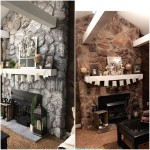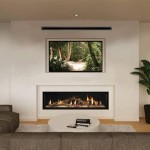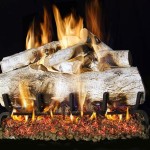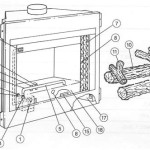Fireplace With Vents: Understanding the Technology and Benefits
Fireplaces have long been a focal point in homes, providing warmth and ambiance. Over time, fireplace designs have evolved, incorporating technologies aimed at improving efficiency and safety. One significant development is the fireplace with vents, a design that aims to enhance heat distribution and overall performance. This article explores the functionality, advantages, and considerations associated with vented fireplaces.
A vented fireplace, also known as a direct-vent fireplace or a forced-air fireplace, distinguishes itself from traditional fireplaces through its construction and operational mechanisms. Unlike open-hearth fireplaces that draw air from the room for combustion, vented fireplaces typically utilize a closed combustion system. This means the fireplace draws air from outside the home through a vent, often a coaxial vent with one pipe inside another. One pipe brings in fresh air for combustion, while the other expels exhaust gases. This closed system minimizes the depletion of oxygen within the living space and reduces the introduction of drafts.
The primary purpose of vents in a fireplace is to manage the inflow of fresh air for combustion and the outflow of combustion byproducts. Without proper venting, carbon monoxide, a colorless and odorless gas, can accumulate inside the home, posing a serious health hazard. Vented fireplaces are designed to mitigate this risk by ensuring that all combustion byproducts are safely expelled outside. The vents themselves can take various forms, including horizontal vents that exit through an exterior wall and vertical vents that extend through the roof.
Improved Heating Efficiency and Distribution
One of the key advantages of fireplaces with vents is their improved heating efficiency. Traditional open-hearth fireplaces often lose a significant portion of their heat up the chimney. Vented fireplaces, particularly direct-vent models, are designed to capture and radiate more heat into the room. The closed combustion system prevents drafts and reduces heat loss, allowing for more efficient heating of the designated space. Moreover, some vented fireplaces include blowers or fans that further enhance heat distribution. These blowers circulate warm air throughout the room, ensuring a more even and comfortable temperature.
The forced-air system, often integrated into vented fireplaces, is designed to further maximize the heating potential. This system operates by drawing cool air from the room and circulating it through a heat exchanger within the fireplace. The heated air is then pushed back into the room through vents, effectively warming the space. This process creates a convective heat flow, which can be more efficient than the radiant heat provided by a traditional fireplace. The integrated blowers and fans contribute to the overall comfort by minimizing temperature variations within the room.
In addition to the improved heating efficiency, the design of vented fireplaces allows for greater flexibility in installation. Unlike traditional masonry fireplaces that require a complex and structurally demanding chimney, vented fireplaces can be installed in a wider range of locations within a home. The relatively simple venting system, often consisting of a small diameter pipe, makes it easier to integrate a vented fireplace into existing construction or new building projects. This flexibility is particularly advantageous for homeowners who want to add a fireplace without undertaking major structural modifications.
Enhanced Safety Features
The safety features inherent in the design of vented fireplaces are a paramount consideration. The closed combustion system, which draws air from outside the home, minimizes the risk of carbon monoxide poisoning. Because the combustion process is contained within a sealed chamber, there is less chance of combustion byproducts escaping into the living space. Furthermore, many vented fireplaces are equipped with safety devices that automatically shut off the gas supply in the event of a malfunction, such as a pilot light outage or a blocked vent.
Another safety feature commonly incorporated into vented fireplaces is a glass front. This glass panel serves as a barrier, preventing accidental contact with the flames and reducing the risk of burns. The glass is typically heat-resistant and designed to withstand the high temperatures generated by the fire. Some models also include a safety screen or mesh overlaying the glass, providing an additional layer of protection, particularly important in households with children or pets. The glass front also contributes to the overall efficiency of the fireplace by trapping heat and radiating it into the room.
Regular maintenance is crucial for the continued safe operation of a vented fireplace. This includes inspecting the vents for obstructions, such as bird nests or debris, and ensuring that the vent connections are secure and leak-free. A professional inspection by a qualified technician is recommended at least once a year to check the overall condition of the fireplace and its venting system. This inspection can identify potential problems before they become hazardous and ensure that the fireplace is operating safely and efficiently.
Variety of Styles and Fuel Options
Vented fireplaces are available in a wide range of styles to complement various home décor preferences. From traditional designs that mimic the appearance of a wood-burning fireplace to contemporary models with sleek lines and minimalist aesthetics, there is a vented fireplace to suit almost any taste. The aesthetic choices extend to the firebox itself, with options including realistic-looking artificial logs, decorative stones, and modern glass media. This variety allows homeowners to customize the look of their fireplace to create a visually appealing focal point.
The fuel options for vented fireplaces also provide flexibility and convenience. Natural gas and propane are the most common fuel sources, offering a clean-burning and efficient alternative to wood. Gas fireplaces eliminate the need for storing and handling wood, reducing mess and hassle. They also offer the convenience of instant ignition and adjustable flame height, allowing for precise control over the heat output. Electric fireplaces, while not technically "vented" in the same way as gas models, offer another vent-free option, providing warmth and ambiance without requiring a chimney or vent.
The integration of smart home technology is also becoming increasingly common in vented fireplaces. Some models can be controlled remotely via a smartphone app, allowing users to adjust the flame height, temperature, and timer settings from anywhere. These smart features add a layer of convenience and customization, enabling homeowners to create the perfect ambiance with ease. The ability to control the fireplace remotely can also contribute to energy savings by allowing users to turn it off when not needed.

Remove Or Cover Up Old Heatilator Vents Hearth Com Forums Home Fireplace Brick Makeover

Fireplace Makeover Reveal Beneath My Heart

Remove Or Cover Up Old Heatilator Vents Hearth Com Forums Home Fireplace Vent

Pros And Cons Of Direct Vent Gas Fireplaces Tarantin Industries
What Is This Vent Above My Firebox Hearth Com Forums Home

Hugedomains Com Fireside Hearth And Home Fireplace Doors

Vented Vs B Vent Direct Free Dixie S

How Direct Vent Fireplaces Work

Vent Cover Set 9x80 Cm 3x For Fireplace With Straight Glass Pane Kratki

Why Does Fireplace Have Vents On The Side Build Homes Hub
Related Posts








